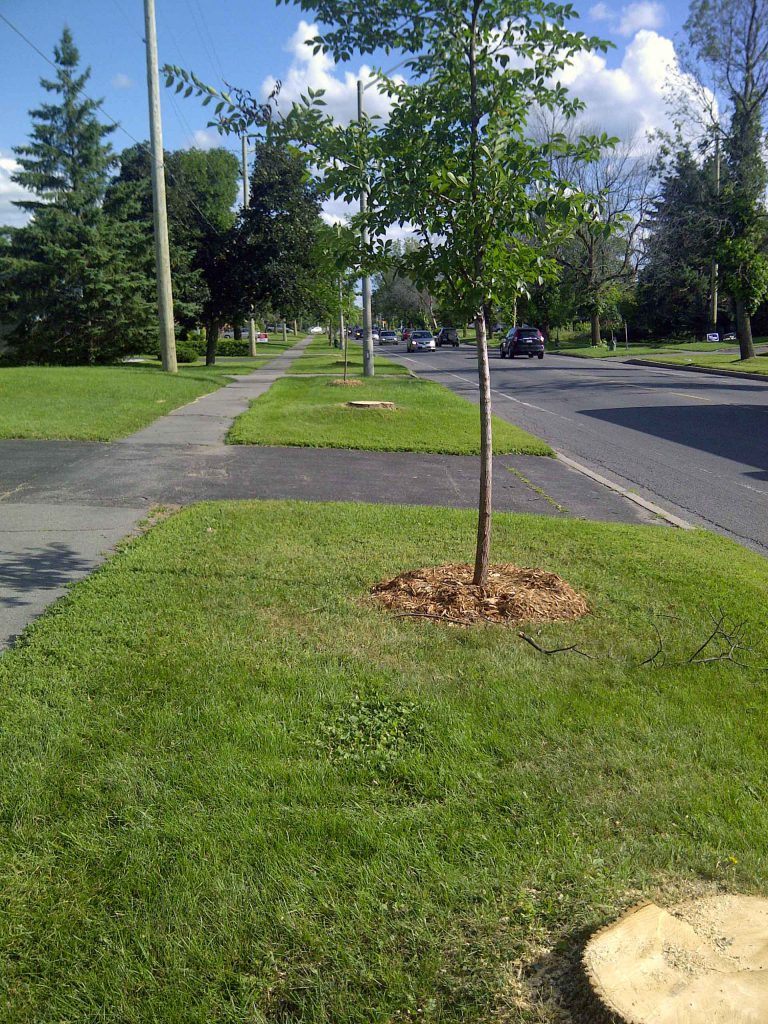Sometimes invasive species establish self-sustaining populations where control and eradication efforts simply won`t work. When that happens, it is important to implement innovative management actions to reduce their impacts and long term costs to Canadians. When we adapt to an invasive species, we take practical steps to protect our communities from the disruptive and damaging impacts that invasive species have on society.
In communities impacted by the emerald ash borer, ash trees are removed from city streets and replaced with other species that are not susceptible to attack. Eventually, the new trees will restore the urban tree canopy and lessen the long term impacts caused by EAB.

Education
- Educational posters, pamphlets, info sheets, or websites explaining the invasive species of the area and ways to avoid introduction or spread of these or new pests to new regions should be developed and offered at all access points
- Communication strategies about high-risk pathways should be implemented to educate the public about activities that could allow for further introduction or spread of invasive pests. As more and more people know about invasive species risks involved with introduction pathways, more of them can take the necessary precautions to avoid further spread of the established invasive species.
- Share knowledge with communities who may have to deal with the same invasive in the future
Research
- Continue research focused on how species become invasive, about introduction pathways, about innovations in control methods, and to better understand the conditions that lead to the spread of invasive species. Once a pest becomes established in one region, it is essential to continue research efforts to prevent further introduction and spread of forest pests to new areas. Also, continued research can help to stay up-to-date on any new control methods that arise for particular invasive species, through which new adapted efforts towards minimizing impacts can be implemented.
- Research focusing on the environmental, social, and economic consequences of the established species. This could help communities and municipalities develop strategies to minimize the negative impacts of the established invasive species over the long term.
- Continue to monitor the population level and geographical spread of the invasive species. Emphasis on monitoring and detection of the species along high-risk pathways leading from infested areas (to ensure the species is not spreading to new areas, or to enable quick management response if it does).
- Develop, research, and implement new control products that target the specific pest. Examples include semiochemicals, (natural chemicals such as pheromones and repellents), pesticides, and herbicides (NRCan, 2014).
- Develop new methods to detect insect and diseases. For example, CFS researchers in collaboration with genome BC, have developed molecular diagnostic methods to identify invasive pests such as Lda moth and sudden oak death. The ability to rapidly and accurately identify an invasive pest, whether as an adult or an egg, a fragment or a full specimen, will allow for early detection and rapid response to control and eradicate an invasive pest before it has a chance to become established (NRCan, 2014).
- Selective breeding of disease-resistant varieties of trees. Through breeding and re-planting programs, these resistant trees can replace the trees lost to invasive pests. This is a strategy that has been used, for example, to replace Dutch elm disease killed elm trees, and that might help save the endangered butternut tree threatened by butternut canker in eastern Canada (NRCan, 2014).
More Information
- Develop and implement case-specific management plans.
- Develop and implement restoration plans for impacted ecosystems.
- When re-planting and replacing lost trees, choose native non-host tree species (always chose a diverse variety of tree species to plant; in the event of a future introduced pest or pathogen, overall impacts will be less).
- Seek out ways in which to utilize damaged and deceased trees. Salvaged trees that have been treated can be used as building materials or as a bioenergy source. Finding a unique or innovative use for damaged or diseased trees is also a possibility; for example, treated salvaged wood can be used for art or to build a one-of-a-kind furniture piece.
- Ensure quarantine barriers are established and enforced to restrict further spread of the invasive pest.
- Continue to apply control efforts (chemical, biological, physical) where appropriate.
